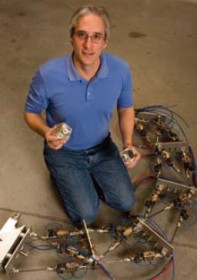
3:30 pm to 4:30 pm
Event Location: NSH 1305
Bio: Gregory S. Chirikjian received undergraduate degrees from Johns Hopkins University in 1988, and the Ph.D. degree from the California Institute of Technology, Pasadena, in 1992. Since 1992, he has been on the faculty of the Department of Mechanical Engineering, Johns Hopkins University, where he has been a full professor since 2001. From 2004-2007 he served as department chair. His research interests include robotics, applications of group theory in a variety of engineering disciplines, and the mechanics of biological macromolecules. He is a 1993 National Science Foundation Young Investigator, a 1994 Presidential Faculty Fellow, and a 1996 recipient of the ASME Pi Tau Sigma Gold Medal. In 2008 he became a Fellow of the ASME, and in 2010 he became a Fellow of the IEEE. He is the author of more than 200 journal and conference papers and primary author on three books: Engineering Applications of Noncommutative Harmonic Analysis (2001) and Stochastic Models, Information Theory, and Lie Groups, Vols. 1+2. (2009,2011).
Abstract: Many stochastic problems of interest in engineering involve random rigid-body motions. In this talk, a variety of stochastic phenomena that evolve on the group of rigid-body motions will be discussed. These include mobile robot path planning, and robot-arm inverse kinematics. These topics lead in to our current work on mult-robot team diagnosis and repair, information fusion, and self-replicating robots. Videos of the latter robots developed by undergraduate student researchers and high school students during summer internships will be shown. These toy models in turn have led us to a deep mathematical investigation. Namely, in order to quantify the robustness of such robots, measures of the degree of environmental uncertainty that they can handle need to be computed. The entropy of the set of all possible arrangements (or configurations) of spare parts in the environment is such a measure, and has led us to study problems at the foundations of statistical mechanics and information theory.
